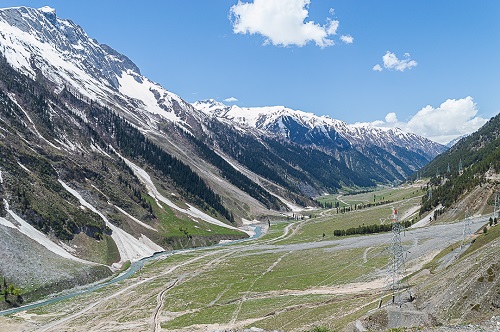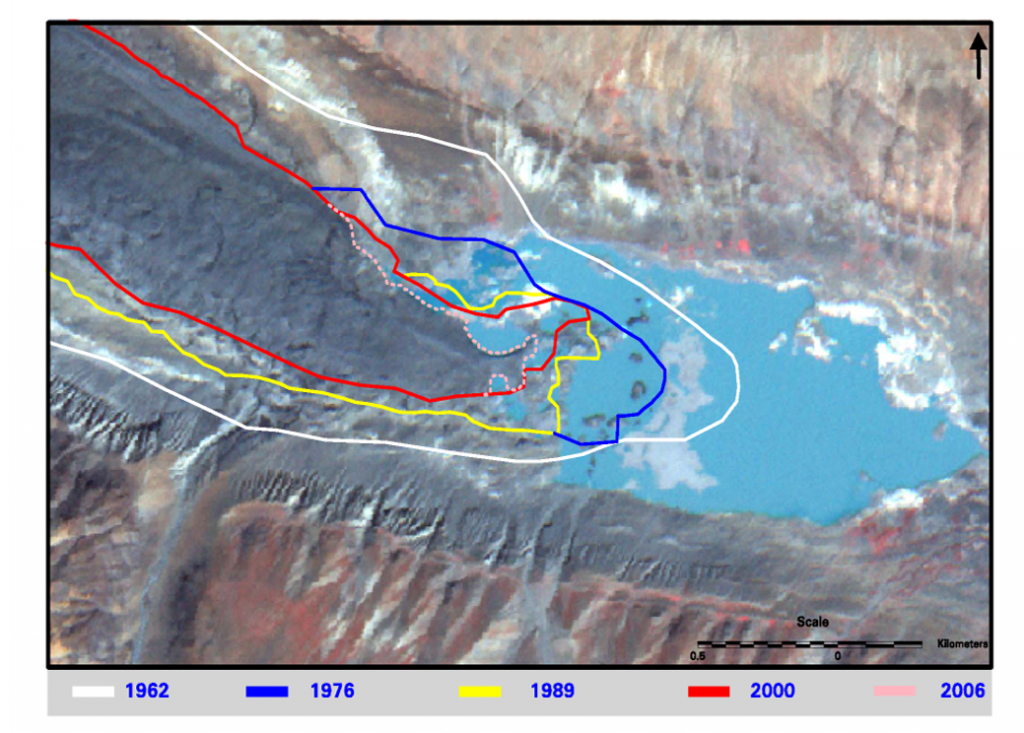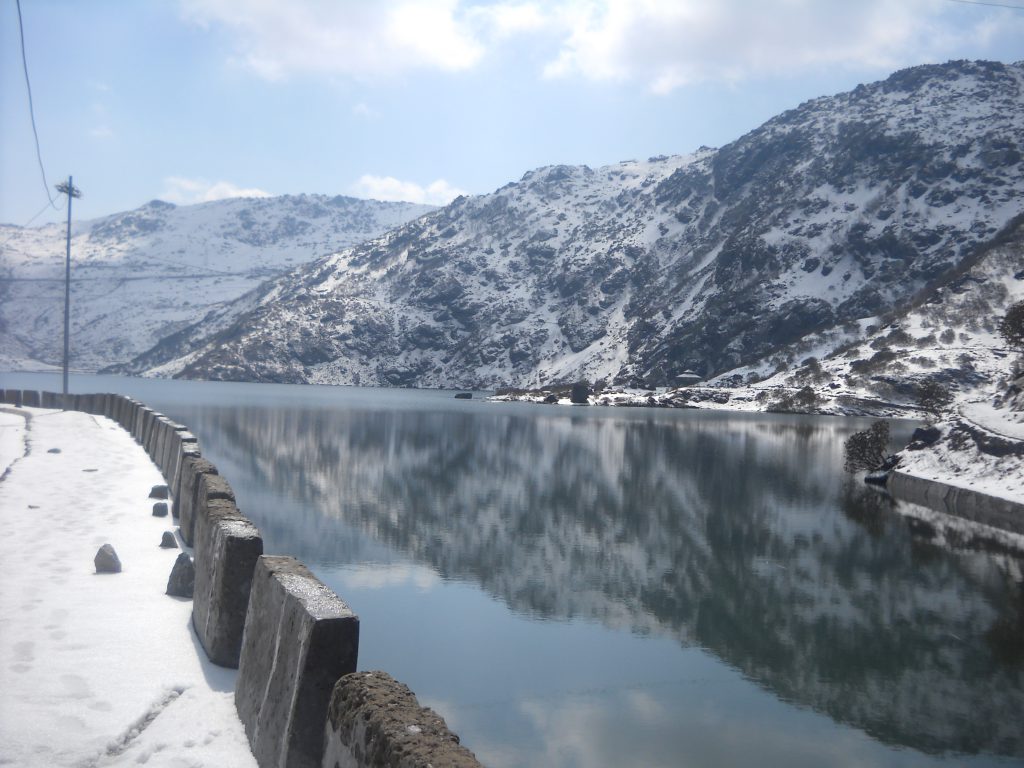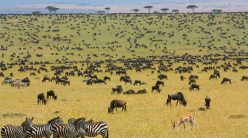Climate change is wreaking havoc on our glaciers

With its myriad colours and the imposing mountains in the background, the confluence of two Himalayan rivers in Ladakh, Zanskar and Indus, is a sight to behold. Not surprisingly, the valley where the rivers meet is thronged by tourists. But Rizwan, a local chauffeur, seems less than amused by the sight of the large number of visitors, even though his livelihood depends on them. He hails from a small village in the Leh valley, and like many others in his village with a farm, he has been forced to take up an alternative career because water, he says, is becoming scarce here, particularly in the summer. His complaint is not unfounded – Ladakh has been facing a drought-like situation in recent years. So how did an area nestled among the snow-capped mountains of the Himalaya with its glaciers and a promise of perennial streams get to this point? While unsustainable tourism is of serious concern and has exacerbated Ladakh’s dry spell, the real culprit is the changing climate, and its effects on glaciers.
Our lifeline
The Himalayan mountain range, stretching from Bhutan in the east to Pakistan in the west, is home to 52.7 million people. It also provides indirect sustenance to the nearly two billion people who live in South Asia. The Himalaya blocks the cold winds from the north during winter and warms the land to its south, drawing the moisture-laden monsoon winds from the Indian Ocean every summer. It also serves as a barrier to these monsoon winds which empty much of their water in the subcontinent. It has another crucial role: it stores freshwater in the colder months in its glaciers, some of which is released in the summer to all the major river systems in the northern part of the subcontinent. These glaciers contain the largest freshwater reserve in the world outside of the polar regions. The Himalaya are bordered in the north-west by the Hindu Kush mountain ranges of Central Asia, and together they are popularly known as The Third Pole.
A glacier is a perennial body of dense ice which constantly moves under its weight. Mountain glaciers, like the ones in the Himalaya, are different from the continental glaciers in Antarctica or Greenland, which are thin slow-moving ice sheets where the freshwater usually flows into the oceans. In the colder months every year, the nearly 56,000 Himalayan glaciers are replenished by snowfall, and in the summer, the glaciers melt. The water from the melting ice flows down the valleys quickly, feeding some of the great rivers of the world along the way: the Ganga, Yangtze, Indus, Brahmaputra and the Mekong. The glaciers are the primary source of their waters, though, for a few months during the monsoon, the rains also provide them with fresh water. These rivers are vital for irrigating the vast agricultural areas in the northern and northwestern plains of the subcontinent, where many crops, including wheat and rice, the staple food grains of the region, are grown. The water from these rivers is also used to produce a huge amount of hydroelectricity. But despite the importance of these glaciers, they have not been studied as well as their polar counterparts. That, however, is changing.
Studying glaciers
How do scientists study glaciers? Apart from staking out in the glaciers to estimate the volumetric snow loss, they also resort to other modern methods like remote sensing via digital aerial photography and the use of satellite images. These monitoring techniques map the perimeter of snow cover. Satellite images help in recording the snowline at the end of each summer which becomes the equilibrium line. Above this line, snow accumulation is more than the loss, and hence the ice remains all through the year. And below this line, there is more loss than accumulation, and therefore the snow has melted at the end of summer.
Field studies continue to be crucial for scientists investigating glacial dynamics. However, they are not easy to carry out. “Glaciology demands a lot of personal sacrifices as well as personal efforts. It needs perseverance,” says Anil Kulkarni, a renowned glaciologist, currently Distinguished Visiting Scientist at the Divecha Centre for Climate Change in IISc.
Kulkarni was one the authors of an influential paper titled “The State and Fate of Himalayan Glaciers”, published in Science in 2012. In the article, the authors discuss the challenges of working in the Himalayan glaciers. “There are few high-elevation weather stations and no long-term field measurement programs on glaciers, and information about the current ice extent is non-uniform and unsatisfactory in places. This can be attributed to the remote location of glaciers, the rugged terrain, and a complex political situation, all of which make physical access difficult,” they write.
Despite these challenges, scientists have been able to collect the data required to study glaciers and how they are changing. Kulkarni recalls that when he started his career back in the 1980s, climate change or snow retreat was not a matter of concern to Indians. He nonetheless continued his quest to study them and even trained in a mountaineering institute. The missions that he has undertaken have presented him with many deadly threats: snowstorms, crevices in the mountains, low oxygen levels and harsh temperatures.

(Image courtesy: Anil Kulkarni)
Kulkarni’s expeditions are usually a result of the combined efforts of researchers, porters, cooks and even mules. These days, he says, access to the Himalaya has improved considerably due to better road connectivity. But some struggles remain the same. “You’re sitting at a 5,000 m altitude, and for 100 km around you, there is no habitat. If you face some problem, there is no one to help you, and you’re on your own. And you’re there for weeks or months,” he says. “So, you’ve to be physically fit, mentally tough and resourceful, and should be able to do whatever you came to do by yourself.” It is challenging, but to Kulkarni, to be able to see the beautiful Milky Way in the night sky in the snow-covered mountains seems worth the trouble. “It can be really rewarding,” he adds.
Disturbing a delicate balance
Scientists like Kulkarni who study glaciers are interested in a critical concept called the mass balance of a glacier. It is the difference between how much ice mass is gained and how much is lost. Glaciers can have a positive or negative mass balance. But typically, in the short term (in geological time scale), glaciers remain in a state of equilibrium, in which the accumulated snow mass is equal to the dissipated snow mass. But the glaciers in the Himalayan region have shown a negative mass balance since the middle of the 19th century. A study carried out by Kulkarni and his team, using a combination of satellite images and field studies, tracked 1,868 glaciers in the Himalaya between 1962 and 2002. It showed that the total glacial area had reduced by a whopping 16%. The retreat of glaciers has been documented by several other studies as well.
In the past few decades, however, the rate of glacial retreat at the Himalaya has accelerated. In a recent study, researchers from Columbia University, USA, found that the rate of snow loss increased more rapidly between 2000 and 2016 than between 1975 and 2000. Published in 2019 in Science Advances, it used data from Cold War-era spy satellite images as well as more recent ones.
The rate of snow loss increased more rapidly between 2000 and 2016 than between 1975 and 2000
A warming planet
The cause of glacial retreat has also been the subject of much scientific investigation. Earth goes through periods of warming and cooling. This fluctuation between greenhouse and icehouse periods has been occurring for millions of years and has played a crucial role in the evolution and distribution of life on the planet. The former is characterised by more carbon dioxide and other greenhouse gases like methane and water vapour, whereas lesser amounts of greenhouse gases in the atmosphere mark the latter. The colder temperatures of an icehouse period result in the formation of both mountain and continental glaciers. Earth is currently in the midst of an ice age called Quaternary glaciation.
In spite of going through an ice age, our planet has been experiencing warmer than expected temperatures since the beginning of the 20th century. This warming has coincided with the release of vast amounts of carbon dioxide and other greenhouse gases due to rapid industrialisation.
According to the Intergovernmental Panel on Climate Change (IPCC), the global average surface temperature of Earth has increased by 1.1°C from 1880 to 2013. An important consequence of human-induced warming is the rapid melting of glaciers, including in the Himalaya. Even more worryingly, the surface air temperature in the Himalaya has increased by 0.65°C during the 1991–2015 period, more than the mean global temperature rise of 0.47°C seen during the same period.

Impact
Discussing the more immediate impact of the melting glaciers, Kulkarni explains, “As the glaciers retreat, they erode the space and depression is created and eventually lakes are formed. The glacial flow carries rocks and debris and keeps dumping them here.” He says that if there is an avalanche, a landslide or earthquakes, these lakes burst resulting in flash floods. Kulkarni and his colleagues at the Divecha Centre have modelled glacial retreats in an attempt to predict lake bursts and the consequences of these floods to the local communities.
What is counterintuitive, however, is that glacial retreat is also leading to droughts in some parts of the Himalaya. Due to the decrease in snow cover, the summer melt-off is no longer an adequate source of water. In places like Ladakh, even the summer showers are not helping as the rocky region is unable to soak up the water. Instead, it is leading to both droughts and floods. The erratic weather has made the traditional farming practices obsolete, and farmers like Rizwan are being forced to either abandon the farms or try to grow different crops. Agriculture, which used to be the main livelihood of people in the hill communities, is no longer a viable option for many.
In the not-too-distant future, the plains of North India are also likely to suffer due to glacial melting. “These [glacial] changes vary across the Indus, Ganges, and Brahmaputra river basins: in the Indus, the marked effect is on meltwater; for the Ganges, the effect is on runoff that is expected to increase; and for the Brahmaputra, climate change may result in enhanced flood risk,” says a report by the think tank Observer Research Foundation. It further states, “ … there would be a decrease in snow and a rise in glacier melt by the middle of the century. Initially, there will be an increased amount of meltwater available, but this quantity will decline abruptly as the glacier storage is reduced.”
Not all the short-term impacts of melting ice in the Himalaya are detrimental to the region. Kulkarni describes an ongoing project between the Divecha Centre and government agencies in the Manali basin to understand the impact of retreating glaciers on the generation of hydroelectricity. They predict that by the end of the century, small glaciers at lower altitudes are going to be significantly affected, and the snow will start melting early. This will lead to a change in seasonality in water availability. The water now available during summers will be accessible during winters, resulting in an increase in power generation in the colder months. Interestingly, due to monsoon rains in the summers, the power generation will not be affected in the warmer months. Climate change, in this instance, can become our ally in increasing power generation. But this is merely a silver lining. The dark clouds have to be dealt with.
The Future
In order to mitigate global climate change, countries around the world will have to cut greenhouse gas emissions and live up to the promises that they have made as part of the Paris Accord on Climate Change, which they signed in 2015. But even if that does happen, many parts of the world are already facing the consequences of a warming planet, and will continue to do so for many decades. Ironically, the communities nestled in the remotest places of the Himalaya, which have almost zero carbon footprint, are paying a hefty price. So is there anything that can be done at the local level to reduce the impact of climate change?
Ladakh may show us the way forward. Already, several projects which seek to address problems arising from the retreating glaciers are being initiated here. For instance, Chewang Norphel, an engineer, is building glaciers. He uses a network of pipes to divert meltwater on the shaded side of the mountain and slow its flow by constructing barriers. This water would freeze at night, creating glaciers that grow each day as new water flows into the basin. So far, he has made 12 such glaciers. These glaciers are helping at least a thousand people living in the lower altitudes. Similarly, Sonam Wangchuk, who inspired Aamir Khan’s character in the movie 3 Idiots, has built “ice-stupas”, artificial glaciers in the shape of a stupa. During summers, these release water steadily, about 5,000 litres each day. The conical shape maximises the amount of ice it can hold while decreasing the area exposed to the sunlight.
In spite of these measures, glaciers will continue to recede if climate change goes unchecked. The good news for them, however, is that they will be restored to their original glory at some point in the distant future, possibly in a few thousand years. But on a time scale that is more meaningful for us, the melting glaciers pose an existential threat to the current and future generations. As Sir David Attenborough reminds us, “However grave our mistakes, nature will ultimately overcome them. The living world will endure; we humans cannot presume the same.”
Gouri Patil, a science writing intern in the Office of Communications (OoC) at IISc, is an Integrated PhD student in the Department of Physics




